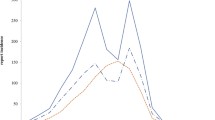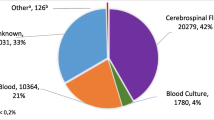Abstract
Vaccination with the measles, mumps and rubella vaccine decreased the mumps incidence in Cuba, but in 2006 and 2007 an outbreak with more than 1000 laboratory confirmed cases occurred, mainly among high school and university students. The objective of the study was to investigate mumps epidemiology in Cuba between 2004 and 2015 and provide an in-depth laboratory characterization of selected samples from mumps patients. Samples from 116 cases (throat swabs, urines, paired acute and convalescent serum samples) were tested for mumps-specific IgM antibodies by ELISA, in a hemagglutination inhibition assay (HIA) or by RT-PCR. IgM antibodies were found in 80.2% of cases. 48.3% of first sera were positive, 30 of which were collected within two days after symptom onset. Testing of all 116 paired sera by HIA showed seroconversion in 55.2% individuals and an at least fourfold increase in antibodies in 44.8% of cases. In 18 out of the 111 vaccinated people (16.2%) no IgM antibodies were detected, neither in the acute nor the convalescent sera, but 14 of them showed seroconversion by HIA and 4 had an at least fourfold increase of hemagglutinin antibody titers. In the RT-PCR, 23 acute phase sera, 4 throat swabs and 5 urines were positive. Detection of mumps-specific IgM antibodies by ELISA and additional diagnostic methods may be required in settings with high vaccination coverage rates.


Similar content being viewed by others
References
Rubin S, Eckhaus M, Rennick LJ, Bamford CG, Duprex WP (2015) Molecular biology, pathogenesis and pathology of mumps virus. J Pathol 235(2):242–252
Jin L, Orvell C, Myers R, Rota PA, Nakayama T, Forcic D et al (2015) Genomic diversity of mumps virus and global distribution of the 12 genotypes. Rev Med Virol 25(2):85–101
Akcali A, Yilmaz N, Uyar Y, Ertek M, Buzgan T (2009) Genotyping of mumps virus circulating in Turkey in the 2006–2007 winter season. Arch Virol 154(11):1807–1812
Carr MJ, Moss E, Waters A, Dean J, Jin L, Coughlan S et al (2010) Molecular epidemiological evaluation of the recent resurgence in mumps virus infections in Ireland. J Clin Microbiol 48(9):3288–3294
Savage E, Ramsay M, White J, Beard S, Lawson H, Hunjan R et al (2005) Mumps outbreaks across England and Wales in 2004: observational study. BMJ 330(7500):1119–1120
Valcarcel M (2007) Comportamiento de la parotiditis en Cuba, años 2000-2006. Instituto Superior de Ciencias Médicas, La Habana, Cuba (Unpublished master thesis)
Ministerio de Salud Publica, Dirección de Registros Médicos y Estadísticas de Salud. Anuario Estadístico de Salud. (2016) ISSN: 1561-4433 La Habana, Cuba
Ribas MA (2011) La vigilancia de laboratorio como soporte fundamental del programa de eliminacion del sarampion, la rubeola y la parotiditis en Cuba, 1988–2007 (Doctoral Thesis). http://tesis.repo.sld.cu/312/1/mariaa_ribas.pdf
World Health Organization (2008) WHO-recommended standards for surveillance of selected vaccine-preventable diseases. http://apps.who.int/iris/bitstream/10665/68334/1/WHO_V-B_03.01_eng.pdf
Albrecht P, Klutch M (1981) Sensitive hemagglutination inhibition test for mumps antibody. J Clin Microbiol. 13(5):870–876
Iizuka M, Saito H, Yukawa M, Itou H, Shirasaka T, Chiba M et al (2001) No evidence of persistent mumps virus infection in inflammatory bowel disease. Gut. 48(5):637–641
Hukic M, Hajdarpasic A, Ravlija J, Ler Z, Baljic R, Dedeic Ljubovic A (2014) Mumps outbreak in the Federation of Bosnia and Herzegovina with large cohorts of susceptibles and genetically diverse strains of genotype G, Bosnia and Herzegovina, December 2010 to September 2012. Euro Surveill.19(33); pii: 20879
MacDonald N, Flegel K (2007) Mumps in young adults: the canary in the coal mine. CMAJ 177(2):121, 3
Gemmill IM (2006) Mumps vaccine: is it time to re-evaluate our approach? CMAJ 175(5):491–492
Sabbe M, Vandermeulen C (2016) The resurgence of mumps and pertussis. Hum Vaccin Immunother. 12(4):955–959
Muhlemann K (2004) The molecular epidemiology of mumps virus. Infect Genet Evol. 4(3):215–219
Acosta G, Ribas MA, Tejero Y, Vázquez S, Piedra D, Cordero Y (2008) Standardization of a capture ELISA for detection of IgM antibodies to parotiditis virus. Rev Cubana Med Trop 60(3):1561
Mankertz A, Beutel U, Schmidt FJ, Borgmann S, Wenzel JJ, Ziegler P et al (2015) Laboratory-based investigation of suspected mumps cases submitted to the German National Reference Centre for Measles, Mumps, and Rubella, 2008 to 2013. Int J Med Microbiol 305(7):619–626
World Health Organization (2009) Special programme for research and training in tropical diseases. Dengue, guidelines for diagnosis, treatment, prevention and control. http://www.who.int/tdr/publications/documents/dengue-diagnosis.pdf
Maillet M, Bouvat E, Robert N, Baccard-Longere M, Morel-Baccard C, Morand P (2015) Mumps outbreak and laboratory diagnosis. J Clin Virol 62:14–19
Narita M, Matsuzono Y, Takekoshi Y, Yamada S, Itakura O, Kubota M (1998) Analysis of mumps vaccine failure by means of avidity testing for mumps virus-specific immunoglobulin G. Clin Diagn Lab Immunol. 5(6):799–803
Rota JS, Rosen JB, Doll MK, McNall RJ, McGrew M, Williams N (2013) Comparison of the sensitivity of laboratory diagnostic methods from a well-characterized outbreak of mumps in New York city in 2009. Clin Vaccine Immunol 20(3):391–396
Vicari AS, Dietz V, Bellini WJ, Icenogle J, Castillo-Solorzano C (2006) Interpretation of measles and rubella serology. In: Andrus JK, de Quadros CA (eds) Recent advances in immunization, 2nd edn. Pan American Health Organization, Washington D.C., pp 80–98
Yermalovich MA, Semeiko GV, Samoilovich EO, Svirchevskaya EY, Muller CP, Hubschen JM (2014) Etiology of maculopapular rash in measles and rubella suspected patients from Belarus. PLoS One 9(10):e111541
Karbone K, Steven Rubin (2007) Mumps Virus. In: Knipe D, Hoeley P (eds) Fields virology, 5th edn. Lippincott Williams and Wilkins, Boston, pp 1528–1550
Tecle T, Johansson B, Jejcic A, Forsgren M, Orvell C (1998) Characterization of three co-circulating genotypes of the small hydrophobic protein gene of mumps virus. J Gen Virol 79:2929–2937
Nojd J, Tecle T, Samuelsson A, Orvell C (2001) Mumps virus neutralizing antibodies do not protect against reinfection with a heterologous mumps virus genotype. Vaccine 19:1727–1731
Acknowledgements
The authors would like to thank the participating staff for reporting and sending samples of mumps cases to be studied in the Reference Laboratory at the Pedro Kouri Institute.
Author information
Authors and Affiliations
Corresponding author
Ethics declarations
Conflict of interest
The authors declare that they have no conflict of interests.
Ethical approval
The study was conducted in accordance with ethical principles expressed in the World Medical Association Declaration of Helsinki. All the procedures involving human participants were in accordance with the ethical standards of the ethics committee at Pedro Kourí Institute of Tropical Medicine (Reference no. CEI-IPK-3712).
Informed consent
Informed consent was obtained from the patients as well as parents and guardians of children provided oral informed consent to the collection of samples for diagnosis.
Additional information
Handling Editor: Bert K. Rima.
Rights and permissions
About this article
Cite this article
Ribas, M.d.A., Tejero, Y., Valcarcel, M. et al. Mumps epidemiology in Cuba between 2004 and 2015. Arch Virol 163, 3059–3064 (2018). https://doi.org/10.1007/s00705-018-3946-z
Received:
Accepted:
Published:
Issue Date:
DOI: https://doi.org/10.1007/s00705-018-3946-z




